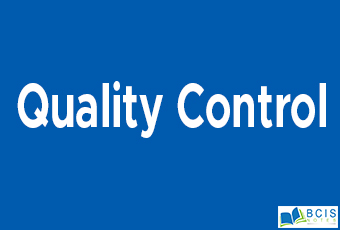
Quality Control
Quality control (QC) is a process through which a business seeks to ensure that product quality is maintained or improved with either reduced or zero errors.
Concept of Quality Control
Quality control requires the business to create an environment in which both management and employees strive for perfection. This is done by training personnel, creating benchmarks for product quality and testing products to check for statistically significant variations. A major aspect of quality control is the establishment of well-defined controls. These controls help standardize both production and reactions to quality issues. Limiting room for error by specifying which production activities are to be completed by which personnel reduces the chance that employees will be involved in tasks for which they do not have adequate training. Quality control, therefore, implies the following five activities:
- Determining tolerances
- Conducting inspections
- Isolating acceptable units
- Bringing causes of deviations
- Suggesting ways and means of improving the quality
Methods of Quality Control
Any variations in the quality of a product, i.e., standards set are mainly caused by variations in raw material, men, machines, methods, and procedures of production and inspection. In order to produce quality products, these variations need to be checked and controlled. There are mainly two methods of quality control.
These are:
1. Inspection:
Inspection, in fact, is the common method used for quality control purposes not only in production but also in services. As regards inspection in production, there are three important aspects involved in it:
(i) Product Inspection:
As the name itself suggests, the product inspection relates to the final product sent into the market. The main purpose of product inspection is to ensure that the products sent into the market comply with the set standard for quality. In other words, it is to ensure that the product ready for sale is perfect and free of defects.
(ii) Process Inspection:
Process inspection proceeds to product inspection. It is aimed at ensuring that the raw material and machines and equipment used in the production process are of prescribed quality and mark.
Process inspection benefits the unit in two ways:
(1) It ensures the manufacturing of a quality product.
(2) It saves wastages of material by preventing process bottlenecks.
(iii) Inspection Analysis:
This is a method based on the analyses of inspections made. The conclusions derived from the inspection analyses help the entrepreneur locate the exact points in the manufacturing process where faults lie. In other words, it enables the entrepreneur to identify the points at which deviations from the standard set start.
2. Statistical Quality Control:
It is an advanced method or technique used to control the quality of a product. This method is based on statistical techniques to determine and control the quality. Sampling, probability, and other statistical inferences are used in this method for controlling the quality of a product. It is widely used in process control in continuous process industries and in industries producing goods on a mass scale. Under this method, the entire lot is, firstly, sampled on the basis of its specific characteristics and, then, is divided into three parts as mentioned below:
(i) Analysis of Samples
(ii) Use of Control Charts
(iii) Corrective Measures.
You may also like: Quality Management

Leave a Reply